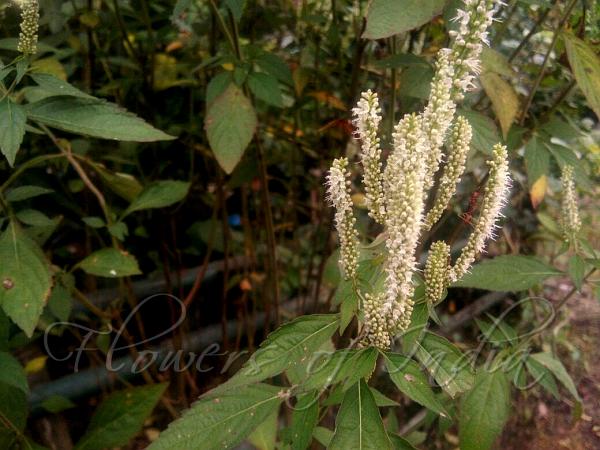|
| Pleasant Himalayan Mint |
|

|

|
|
|
|
Photo: |
Botanical name: Elsholtzia blanda Family: Lamiaceae (Mint family)
Synonyms: Perilla elata, Aphanochilus blandus
Synonyms: Perilla elata, Aphanochilus blandus
Pleasant Himalayan Mint is an erect herb, 1-1.5 m
tall. Stems and branches are densely velvet-hairy. Leaf-stalks are 3-15
mm, densely velvet-hairy; leaf blade elliptic to elliptic-lanceshaped,
3-16 x 0.8-4.5 cm, above finely velvet-hairy, glandular, below
gray-green, hairless, bristly on veins, base narrowly wedge-shaped,
margin sawtoothed, tip tapering. Flowers are borne in spikes at
branch-ends or in leaf-axils. Flower-spikes are one-sided, 4-8 cm long,
mostly velvet-hairy; verticillasters 7-10-flowered, short stalked;
bracts subulate to lanceshaped-subulate, 1.5-3 mm. Flower-stalks are
less than 1 mm. Calyx is cylindric, 2-2.5 mm, bristly outside, teeth
lanceshaped; fruiting calyx slightly dilated at base, ovoid. Flowers
are white, 3-4 mm, bristly outside, nearly hairless inside, funnelfrom,
throat up to 2 mm wide; upper lip notched; middle lobe of lower lip
nearly circular, slightly concave; lateral lobes semicircular, margin
entire. Anterior stamens protruding, posterior 2 slightly longer.
Nutlets are yellow-brown, oblong, about 0.8 mm. Pleasant Himalayan Mint
is found in the Himalayas, from Nepal to Bhutan, Bengal, NE India, SW
China, Burma, Indo-China, Malaysia, at altitudes of 800-2500 m.
Flowering: June-October.
Medicinal uses: Fresh leaves are eaten for
reducing high bloods pressure. Extract of inflorescence is used as
gargle in tonsillitis. Leaf paste is applied on forehead in dizziness.
Leaf decoction is eaten in cough and dyspepsia. Leaf infusion is useful
for application to apathy and sore throat.
Fresh leaves are eaten for
reducing high bloods pressure. Extract of inflorescence is used as
gargle in tonsillitis. Leaf paste is applied on forehead in dizziness.
Leaf decoction is eaten in cough and dyspepsia. Leaf infusion is useful
for application to apathy and sore throat.
Medicinal uses:
 Fresh leaves are eaten for
reducing high bloods pressure. Extract of inflorescence is used as
gargle in tonsillitis. Leaf paste is applied on forehead in dizziness.
Leaf decoction is eaten in cough and dyspepsia. Leaf infusion is useful
for application to apathy and sore throat.
Fresh leaves are eaten for
reducing high bloods pressure. Extract of inflorescence is used as
gargle in tonsillitis. Leaf paste is applied on forehead in dizziness.
Leaf decoction is eaten in cough and dyspepsia. Leaf infusion is useful
for application to apathy and sore throat. | Identification credit: Thingnam Sophia, Thingnam Rajshree | Photographed in Imphal, Manipur. |
• Is this flower misidentified? If yes,